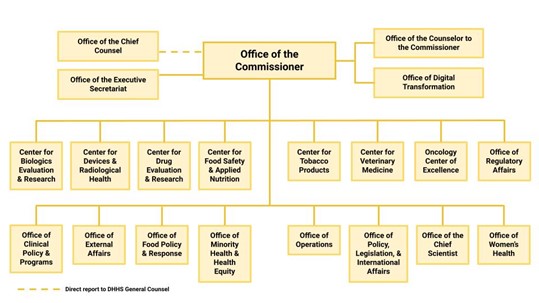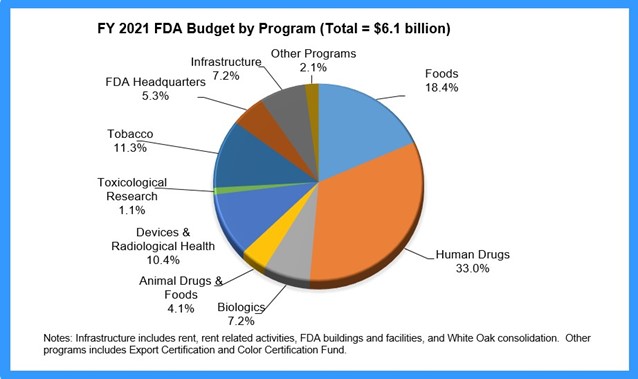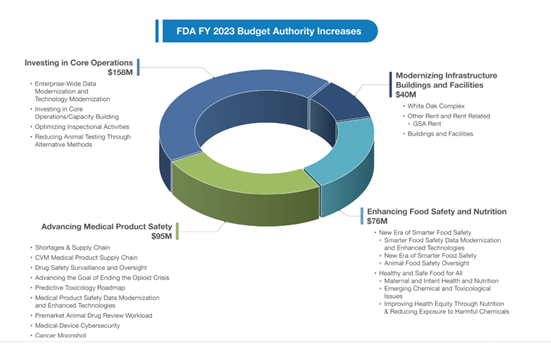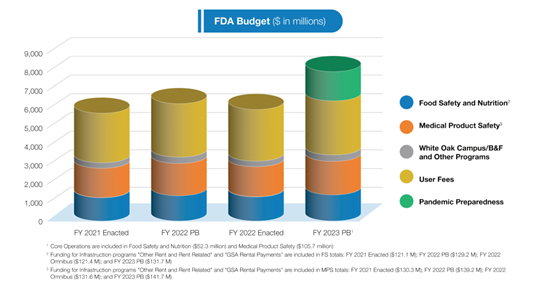The Food and Drug Administration (FDA), an agency within the U.S. Department of Health and Human Services (HHS), oversees food, medical, and related products for safety and efficacy. As the oldest comprehensive consumer protection agency in the U.S., the FDA is encountering increased responsibilities due to related advancements. Enhancing consumer safety, countering and preventing supply chain shortages, and increasing technological and data modernization are current priorities for the FDA.
History, Mission, and Organization
The FDA is concerned with the safety, efficacy, quality, and lawfulness of medical products, food, dietary supplements, cosmetics, animal and veterinary products, radiation-emitting products, and tobacco products. As such, it facilitates innovations that make medical products more effective, safe, and affordable; ensures products are properly labeled; educates the public about the effects of tobacco products; and provides accurate, science-based information so the public can make informed decisions. The FDA also engages in counterterrorism practices by overseeing the security of the food supply and developing medical products that can respond to public health threats.
The FDA’s Public Health Agenda prioritizes:
- Public health and consumer protection
- Modernization to keep pace with evolving science and technology
- Emergency preparedness and response
The FDA protects consumers from food through research and development, inspection, sampling, recall, seizure, injunction, and criminal prosecution. It also has legal regulatory authority to act when safety issues arise.
While the FDA’s origins extend back to the creation of the Agricultural Division in the Patent Office in 1848, it began in 1906 with the “Food and Drugs Act”, a collection of 200 laws that created one of the world’s most comprehensive and effective networks of public health and the consumer protections. The Food and Drugs Act is the first comprehensive federal consumer protection law and the centerpiece of the Progressive Era legislation. The Federal Food, Drug, and Cosmetic Act of 1938 allowed the FDA to inquire about evidence of safety for new drugs, create standards, and undertake factory inspections. This was strengthened by the Kefauver-Harris Amendments of 1962 and the Medical Device Amendments of 1976. The FDA received its current name in 1930.
The FDA comprises the Office of the Commissioner and four directorates overseeing the agency’s core functions: Medical Products and Tobacco, Foods and Veterinary Medicine, Global Regulatory Operations and Policy, and Operations. There are approximately 18,000 full-time employees. Below is the FDA’s organizational chart.

FDA in Action
The FDA regulates 78% of the U.S. food supply, totaling about $1 trillion worth of products each year. There are over 20,000 prescription drugs approved for marketing, 6,700 medical device product categories, 1,600 FDA-approved animal drug products, and 100,000 tobacco products overseen by the FDA. However, its website has numerous broken hyperlinks and has not updated its “Recent News and Innovation” Sites since 2015. The following are some of the projects and actions the FDA has taken in support of its primary mission.
The FDA often collaborates with other agencies and departments, both within and independent of HHS. The National Institutes of Health (NIH) and FDA worked together on 348 activities in FY2020 alone. These included training, scientific research, and resource developments on products the FDA oversees. Additionally, in a crisis, the FDA may work with the Department of State (DOS) or Department of Defense (DOD) to act swiftly and purposefully.
Strengthening Maternal and Infant Health and Nutrition: As part of the FDA’s 2021 priority to reduce chronic disease through nutrition, the FDA undertook a number of activities to promote proper health and nutrition for infants and pregnant women. The FDA collaborated with NIH on a workshop that explored how bioactive ingredients are used in infant formula. The FDA also produced the Infant Formula: Safety Do’s and Don’ts in response to several babies being hospitalized from low calcium levels after being fed homemade formula. This year, President Biden invoked the Defense Production Act (DPA), which gives the government more control over industrial production during emergencies, to combat the infant formula shortage caused by supply chain issues and the closure of a major domestic formula plant. The FDA has provided instructions for the plant, owned by Abbott Nutrition, to complete in order to restart production. HHS is using the DOD’s commercial planes to import formula in Operation Fly Formula, making sure formula is being imported quickly and meeting health and safety standards.
Medical Countermeasures Initiative (MCMi): The FDA secures medical countermeasures, such as drugs, vaccines, and diagnostic tests, to counter chemical, biological, radiological, nuclear, and emerging infectious disease threats. MCMi is an agency-wide initiative that coordinates medical countermeasures in support of this mission. MCMi supports research, including into regulatory science research tools like Zika virus reference materials. It also helps ensure U.S. laws, regulations, and policies support preparedness and response to threats. MCMi even offers preparedness information for consumers in the event of natural disasters or other drastic occurrences.
Human Healthcare Linked to Puppy Bacterial Outbreak: The Center for Veterinary Medicine (CVM) combated a 2017 bacterial outbreak using its One Health approach that recognizes the connection between people and animals to seek the best health for all. CVM identified pet store puppies as the source of an illness due to a multi-state outbreak of antimicrobial-resistant Campylobacter. The infected puppies were transferring the bacteria to humans, making them sick as well. CVM tested different drugs to determine which ones could kill the bacteria, ultimately finding two unconventional drugs that successfully treated the illness in humans. This was a joint effort between the FDA, the Center for Disease Control (CDC), and the U.S. Department of Agriculture (USDA), but it was driven and expedited by the FDA’s previous years of research.
The Personal Care Products Safety Act: Kourtney Kardashian, a reality star and entrepreneur, has been working with the Environmental Working Group (EWG) on Cosmetic Legislation that would increase FDA oversight in the beauty industry. It has been 80 years since relevant laws were passed. Kardashian wants to prevent harmful chemicals used in cosmetic products and has been working with the FDA to ensure these types of products can be regulated effectively. EWG and Kardashian are supporters of the Personal Care Products Safety Act, which would give the FDA the authority to review chemical elements in personal care products to properly determine if these ingredients are present at safe levels and to recall and stop the production on unsafe products. A portion of the revenue from the personal care products industry will finance the FDA’s new safety reviews and oversight.
Contract Procurement and Acquisition
The FDA aims to award contracts and grants on a competitive basis, emphasizing quality, efficiency, and economic value. The Office of Acquisition & Grants Services (OAGS) is responsible for awarding contracts, grants, and interagency agreements. FDA contracts are completed in accordance with the FAR and the HHS Acquisitions Regulations (HHSAR). All invoices for FDA awards are paid by the Division of Payment Services (DPS).
Upcoming contracting opportunities are posted on the Procurement Forecast Data Repository (PFDR), along with the rest of the contract opportunities within HHS. Current opportunities are posted on SAM.gov. The FDA eBidBoard, an electronic system that publicizes business opportunities for contract actions with an anticipated value between $15,000 and $25,000, is another resource available to prospective applicants. The FDA also hosts an Annual Small Business Outreach Vendor Fair.
Recent Contracts
The following are recent contract opportunities solicited by the FDA:
- Upgrade Ventilation and Cooling in Data Center: The FDA National Center for Toxicological Research (NCTR) needed to upgrade the ventilation and cooling in a data center located in Jefferson, Arkansas. This contract was a Historically Underutilized Business (HUBZone) Set-Aside. In March 2022, AVCOR Construction, LLC won the $1.3M Firm-Fixed Price contract.
- Cybersecurity Compliance BPA: In February 2022, TACG, a Copper River Company, was awarded a $50M single-award BPA with for cybersecurity compliance.
- Executive and Sr. Level Non-Clinical Staffing BPA: In February 2022, AE Strategies LLC was awarded a 5-year single-award BPA contract to provide qualified executive level or senior level candidates across the FDA enterprise, for any FDA center and office staffing requirements.
- Surveillance Activities for Safety and Effectiveness of Biologics: In December 2021, FDA issued a 3-year $17M contract award to IBM in support of surveillance activities for biologics safety and effectiveness (BEST Initiative).
- Differential Scanning Calorimeter: The Center for Devices and Radiological Health (CDRH) requested a Differential Scanning Calorimeter, a fundamental analytical tool that performs thermal analysis of materials by measuring temperature and heat flow associated with thermal changes and generates the information needed to understand the material properties. Using simplified acquisition procedures, Perkinelmer Health Sciences, Inc. won the $88K contract in September 2021.
Contract Spending Trends
FDA procurement is a competitive environment; in FY16, the FDA competed 91% of its actions, and 94% of FDA dollars were competitively awarded.
Common Products and Services the FDA Purchases:
- Information Technology services, hardware, and software.
- Office furniture, equipment, and supplies
- Animal feed
- Bedding and cages
- Laboratory glassware
- Chemicals and supplies
- Pharmaceuticals, drugs, and intravenous solutions
- Electronic components and supplies
- Plastic and metal rods, sheets, and tubing
- X-ray equipment
- Scientific equipment
- Laboratory furniture, equipment, and supplies
- Animals for research (including horses, calves, cats, dogs, guinea pigs, chicks, hens, etc.)
- Research studies
- Investigations, surveys
- Tests and analyses of a scientific or medical nature
- Examinations, surveys, inspections, and reviews
- Management evaluations/Consulting Services
- Conference support
- Training
- Construction renovation
- Construction management projects
- Architect/engineering support
- Operation and maintenance of facilities Facilities support (e.g. custodial, trash, guard services
In FY2019, 54% of the FDA’s $6.1 billion budget was provided by federal budget authorization. The remaining $2.8 billion was paid for by industry user fees. A breakdown of the FY2021 FDA budget by the program can be found below, followed by a bar graph of how much funding was federally appropriated and how much was funded by user fees. The largest recipients were the human drugs and foods programs.


Grants
The FDA also awards grants and posts its grant application packages on Grants.gov. However, unsolicited applications, except for those directed to the CVM, should be submitted through NIH.
The majority of grants are performed in California, Arizona, and Maryland.
Top Grant Recipients FY17-21:
- The Critical Path Institute
- Association of Food & Drug Officials
- Medical Device Innovation Consortium
- Duke University
- The Regents of the University of California, San Francisco
- Yale University
- National Environmental Health Association
- Illinois Institute of Technology
- Massachusetts Institute of Technology
- California Department of Food & Agriculture
For example, the FDA awarded 11 new clinical trial research grants in October 2021 to develop new medical products for rare disease treatments. This was done through the Congressionally-funded Orphan Products Grants Program, which seeks to meet the current and future health needs of those who suffer from a rare disease. Some of the trials research infant diseases and brain cancers. The grants total $25 million over four years. Armgo Pharma, INC., Boston Children’s Hospital, and Duke University are among the winners.
FDA in 2023 and Beyond
The FDA’s responsibilities are becoming larger and more complex because of developments in food and medical product technology, global supply chains, and artificial intelligence.
The FY2023 Budget Request is $8.4B, a $158 million increase from FY2022. The $8.4B request includes $3B in user fees. The FDA’s priorities are to enhance food and safety nutrition, advance medical product safety, improve core operations, and modernize the FDA’s infrastructure. It also wants to update scientific practices to reflect public priorities.
The FDA has legislative proposals for enhanced authorities related to shortages and information sharing with the states and to require medical device manufacturers to consider cybersecurity issues. The budget also allocates $1.63B over the next five years for Pandemic Preparedness. The two graphs below show where the budgetary increases are, as well as how the budget has changed since FY21.


The pharmaceutical supply chain is complex, international, and susceptible to disruptions; it is influenced by market factors that relate to the increased reliance on foreign countries to manufacture medicine and their starting materials. The FDA identified the following threats to the U.S. drug supply chain from abroad: counterfeit, diversion, theft, and product control and safety. In the past, the FDA has partnered with the members of the Asia Pacific Economic Cooperation (APEC) to enhance product quality and supply chain safety, creating the Supply Chain Security Toolkit for Medical Products.
HHS, FDA’s parent agency, produced the Public Health Supply Chain and Industrial Base One-Year Report that recommended new strategies the U.S. Government can use to address vulnerabilities in the supply chain, including personal protective equipment, medical equipment, testing and diagnosis, and pharmaceuticals and vaccines. As a whole, the FDA is shifting to increase domestic production. The FY23 budget contains a $95 million increase for the FDA’s medical product safety work, including on the supply chain.
FDA is also moving towards more automation, mainly focusing on analyzing data in daily business operations with minimal training. FDA will transfer this to its user experience in FDA’s digital transformation plan. It plans to utilize machine learning as part of its modernization strategy.
Researched and authored by Haley Boulanger, Pulse Analyst.
